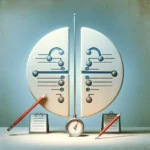**Split-Half Reliability in Cognitive Testing**
Split-half reliability is a measure of consistency used in the field of cognitive testing and psychological assessment. This statistical tool assesses the internal consistency of a test, ensuring that the results are stable and the test is reliable over time. When evaluating cognitive abilities such as memory, attention, language, and problem-solving skills, split-half reliability helps guarantee that a test produces consistent scores, contributing to its overall validity and usefulness.
**Definition:**
Split-half reliability refers to a method where a test is divided into two parts, and the scores from each half are compared. If the two halves of the test yield similar results, the test is considered to have high split-half reliability.
**Importance in Cognitive Testing:**
In cognitive testing, split-half reliability is crucial because cognitive abilities can be complex and multifaceted. Tests with high split-half reliability provide confidence that the outcomes are not due to chance or random variation but are a true representation of a person’s cognitive abilities.
**Calculating Split-Half Reliability:**
The process involves several steps:
1. A test is administered to a group of individuals.
2. The test is split into two equal halves, which could be based on even and odd items, first and second half, or through a random selection of items.
3. The scores from each participant on both halves are correlated.
4. Reliability is assessed by using the correlation coefficient, which ranges from -1.0 to 1.0. Higher positive values indicate higher reliability.
**Challenges and Considerations:**
Achieving high split-half reliability can be challenging due to factors like test length, diversity of content, and individual differences in test-takers. It’s also important to note that split-half reliability is only one aspect of a test’s reliability; other forms such as test-retest reliability and inter-rater reliability are also essential.
**Implications for Test Development:**
During the development of cognitive tests, split-half reliability is taken into account to ensure that each item on the test contributes to its intended purpose. Test developers work to balance the content and difficulty across both halves of the test to achieve consistent results.
**Conclusion:**
Split-half reliability plays a significant role in the field of cognitive testing. By providing a means to measure the internal consistency of tests, it helps psychologists and researchers create and refine tools that accurately assess cognitive abilities, which is fundamental for diagnosing conditions, tracking cognitive changes over time, and developing targeted interventions.

